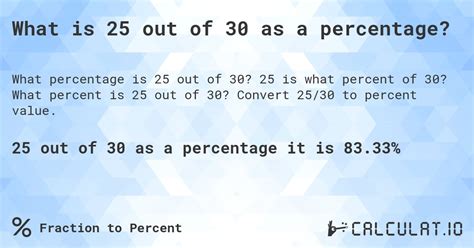25 Is 30 Percent Of What Number
Kalali
Apr 01, 2025 · 4 min read

Table of Contents
25 is 30 Percent of What Number: A Comprehensive Guide to Percentage Calculations
Many everyday situations require understanding percentages. Whether you're calculating discounts, figuring out tax amounts, or determining your grades, the ability to work with percentages is crucial. This article will delve deep into how to solve the problem "25 is 30 percent of what number," explaining the process step-by-step, providing alternative methods, and exploring related percentage concepts. We'll also look at practical applications and how to avoid common mistakes.
Understanding the Problem: Deconstructing "25 is 30% of What Number?"
The question "25 is 30 percent of what number?" presents a classic percentage problem. It's asking us to find the original whole number from which 25 represents 30%. Understanding this structure is key to solving it correctly. We know the following:
- Part: 25 (this is the 30% portion of the whole)
- Percentage: 30% (this represents the proportion of the whole)
- Whole: This is the unknown value we need to calculate.
Method 1: Using the Percentage Formula
The most straightforward approach to solving this problem is using the basic percentage formula:
Part = (Percentage/100) * Whole
We can rearrange this formula to solve for the "Whole":
Whole = (Part * 100) / Percentage
Now, let's plug in the values from our problem:
- Part = 25
- Percentage = 30
Whole = (25 * 100) / 30
Whole = 2500 / 30
Whole = 83.333...
Therefore, 25 is 30% of approximately 83.33.
Method 2: Using Proportions
Another effective method involves setting up a proportion. A proportion is an equation that states two ratios are equal. We can represent our problem as follows:
25/x = 30/100
Where:
- 25 represents the part
- x represents the whole (the unknown value)
- 30/100 represents 30% as a fraction
To solve for x, we can cross-multiply:
25 * 100 = 30 * x
2500 = 30x
Now, divide both sides by 30:
x = 2500 / 30
x ≈ 83.33
This method confirms our previous result: 25 is 30% of approximately 83.33.
Method 3: Using Decimal Equivalents
Percentages can easily be converted to decimals by dividing by 100. 30% is equivalent to 0.30. We can then rewrite the problem as:
25 = 0.30 * x
To solve for x, divide both sides by 0.30:
x = 25 / 0.30
x ≈ 83.33
Again, we arrive at the same answer. This method highlights the interchangeability between percentages and decimals in solving these types of problems.
Practical Applications and Real-World Examples
Understanding how to calculate percentages is essential in numerous real-world situations. Here are a few examples:
-
Sales and Discounts: If a store offers a 30% discount on an item and the discount amount is $25, you can use this method to determine the original price of the item.
-
Taxes: If a sales tax of 30% on a purchase amounts to $25, this calculation helps you find the pre-tax price.
-
Grade Calculations: If 25 points out of a total score represent 30% of the total grade, you can find the total possible points.
-
Financial Analysis: Percentages are frequently used in analyzing financial statements, such as calculating profit margins, return on investment (ROI), and debt-to-equity ratios.
-
Surveys and Statistics: Understanding percentage calculations is vital for interpreting data from surveys, polls, and statistical analyses.
Common Mistakes to Avoid
While percentage calculations are relatively straightforward, several common mistakes can lead to incorrect answers:
-
Incorrect Formula Application: Ensure you use the correct formula and rearrange it appropriately depending on the unknown variable you are solving for.
-
Decimal Errors: Be mindful of decimal placement, especially when working with decimal equivalents of percentages. A misplaced decimal point can significantly alter the result.
-
Calculation Errors: Double-check your calculations to avoid simple arithmetic errors. Use a calculator if needed to ensure accuracy.
-
Misinterpretation of the Problem: Carefully read and understand the problem statement to identify the known and unknown variables correctly.
Expanding Your Percentage Knowledge: Related Concepts
Mastering percentage calculations opens the door to understanding other related mathematical concepts:
-
Ratios and Proportions: Percentages are essentially ratios expressed as a fraction of 100.
-
Fractions and Decimals: Percentages can be easily converted to and from fractions and decimals.
-
Interest Calculations: Compound interest and simple interest calculations heavily rely on percentage concepts.
-
Statistical Analysis: Percentages are fundamental in describing and interpreting statistical data.
Conclusion: Mastering Percentage Calculations for Everyday Success
The ability to solve problems like "25 is 30 percent of what number?" is a valuable skill with widespread applications. By understanding the underlying principles, employing different methods, and avoiding common pitfalls, you can confidently tackle percentage calculations in various contexts. Whether you're shopping for a sale item, analyzing financial data, or interpreting survey results, your newfound expertise will greatly enhance your problem-solving capabilities and empower you to make informed decisions in your daily life. Remember that practice is key – the more you work with percentages, the more comfortable and proficient you will become.
Latest Posts
Latest Posts
-
12 Out Of 18 As A Percentage
Apr 02, 2025
-
What Is A 36 Out Of 50
Apr 02, 2025
-
Describe The Cross Section Of The Rectangular Prism
Apr 02, 2025
-
7 Liters Is How Many Gallons
Apr 02, 2025
-
Is Baking Soda A Compound Element Or Mixture
Apr 02, 2025
Related Post
Thank you for visiting our website which covers about 25 Is 30 Percent Of What Number . We hope the information provided has been useful to you. Feel free to contact us if you have any questions or need further assistance. See you next time and don't miss to bookmark.
